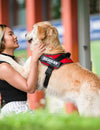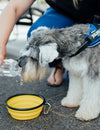
Dog harnesses were originally designed for pulling loads such as dog sledges, for attaching equipment or simply for displaying attention grabbing signs.
Why then, in modern times, would a dog owner choose a harness instead of a collar for their dog?
Modern day dog harnesses are practically all based on harnesses used in the equestrian world. Draft animals have been pulling heavy carts for years. It’s worth looking at the different options available and discussing which one is better for your dog.
Equine Harnesses
Traditionally, there were three different styles to choose from:
1) Neck and Girth Harness
Neck and girth harnesses were brought to Europe from China over 2000 years ago. They were used by ancient civilizations for draft animals, and also used in battle by the cavalry forces of that era.

2) Breast Strap Harness
Breast strap harnesses, also known as chest harnesses, dating back to Roman times, were introduced because of the “choking” effect of neck and girth harnesses. The physical pressure that these applied to the respiratory system prevented draft animals from exerting themselves fully, so chest harnesses allowed animals more freedom to breathe, allowing them to work more efficiently.

3) Collar and Harness
Full collar harnesses were designed and most commonly used in Europe for specific animals to pull heavy loads. This type of harness allowed the horse to use its full weight, resulting in a more ergonomic design than the breast strap harness.

Canine Harnesses
From ancient fighting dogs to modern rescue dogs
In ancient times, dog harnesses were developed mainly for dogs working in special deployment areas e.g. where strong-bodied dogs took an active part in combat, engaging in battle for both attack and defence. Dogs were also used for guard duties in war zones.
With the onset of World War 1, service dogs began to be used as rescue and messenger dogs. As in other areas of life, technological advances prompted by conflict led to developments in other walks of life in subsequent times of peace.
As an example, In 1849, during the American Gold Rush, dogs were used for pulling sledges in the same way as they’d pulled carts previously in battles, and after World War 1, the first guide dogs were used, using harnesses developed for wartime purposes, that still provide the freedom of movement for the dogs.
The early twentieth century began to see further development of dog equipment and harnesses.
Summary – dog harnesses were used in the following fields:
- In ancient times: for taking part in active combat as an attacking force
- In ancient times and up to present day: for pulling sleds or heavy loads
- During World War 1: for rescue and for the carrying of medical supplies
- Post World War 1: for guiding the blind
Current uses of Dog Harnesses
Nowadays dog harnesses are used for a far wider range of purposes. Demands for new functions are continually emerging as dogs become more involved in a wider range of activities.
Present day harnesses can be used for:
- Walking a dog (with high visibility vests for night time walks)
- Rehabilitation of injured dogs
- Swimming
- Rescue as carrying harness
- Displaying signs and labels
The Increasing Popularity of Dog Harnesses
Harnesses began to receive more recognition in the 1990’s as a result of campaigning by animal rights activists. A harness appears to be more comfortable, putting less stress on a dog’s neck than a collar. As one critic of dog collars said. “We call dogs ‘man’s best friend’, and then we drag them by their neck? It doesn’t make sense, and that’s one of the main reasons for the increasing popularity of dog harnesses. They are intuitively better for a dog’s general health.
Types of Dog Harnesses
Modern dog harnesses (like horse harnesses) can be divided into two main groups:
1) Y-harnesses (full collar harnesses / collar and hames harnesses)
2) Breast Strap Harnesses (chest harnesses)
Both types of harness can include an additional saddle piece, with or without lining and they can have variable strap widths. Each of these versions is suitable for walking a dog on a leash. Harnesses are meant to be worn just for one or two hours a day, as well as on daily walks.
”Y” Harnesses
Collar and hames harnesses are positioned between the neck and the shoulder joints. The strap surrounding the neck allows the animal to exert its pulling force optimally, on the whole area of the chest and spine. It is no coincidence that this type of harness is used for pulling sleds: it’s efficient and comfortable.
”Y” harnesses have been developed specifically for dogs, as a derivation of the collar and hames harnesses used for horses. The best-known examples are the dog sled harnesses perfected for pulling loads, which have developed into their current form over centuries, and have recently become well-known as everyday dog harnesses.
Padding
Today, in addition to pulling sleds, Y-harnesses are used for weight pulling sports and for search dogs.All Y-harnesses have padding connected to the neck strap, extending under the belly, parallel to the spine. This padding, extending under the chest and the belly, can either be incorporated into the dog harness, or added later. Extensive padding can cause complications during street use, because the areas close to the ground, under the chest and the belly, are more prone to getting dirty, with mud sticking to them. Therefore, it’s practical to use removable padding; this improves the general comfort of the dog, as well as making it easier to remove for regular cleaning.
In the version of Y-harnesses designed for pulling sleds, the leash is attached to the back one-third of the body of the dog. This is optimally located both in terms of comfort and for maximal pulling force.
Strap Width
Wide straps dissipate the pressure applied to the dog’s body when pulling, and they help to align the body of the dog properly when led on a leash. For older dogs who have more restricted movements, extra padding on these wide straps makes harnesses even more comfortable and efficient.
Y-Harness models suitable for everyday wear are available – the leash can be attached to the front of the harness to make handling easier, rather than to the back, as for pulling loads. The skills and ability of the dog handler need to be taken into consideration when choosing this type of harness: it can take time and practice to become proficient at working with a dog wearing one.
The Advantages of Y-harnesses
- The strength of the spine and chest muscles can be used to the fullest extent, thanks to the placement of the straps along the line where the shoulder muscles meet the neck.
- The dog can use its full weight to pull in an efficient, ergonomic manner.
- The harness can be combined with a saddle part, which allows the attachment of high visibility flashings as well as other accessories on the back and side of the dog.
The Disadvantages of Y-harnesses
- They can be fiddly to put on the dog: the adjustment of the buckles and side adjusters is complicated, especially if you are not familiar with the way they work.
- If incorrectly fitted, Y-harnesses can put pressure on the windpipe, as well as on the blood vessels of the neck.
- They cannot be used for guide dogs.
- Some dogs do not like straps touching their neckline. A different type of harness should be used in these cases.
- Inadequate lining on the straps used around the neck can cause unnecessary pulling and tugging.
- The whole harness has to be cleaned as chest pads are rarely detachable.
The Products Offered by Julius-K9 Canada
The mantrailing/outdoor Y-harness sold by Julius-K9 (2017) has an elasticated leash holding anchor, which can extend by 2 centimeters. This has a bungee-type effect, preventing harsh pulling or tugging. When wearing this harness during a working session or an active walk this ensures optimum comfort for the working animal, as well as easing the impact on the hand and shoulder joints of the handler holding the leash.
Chest Harnesses
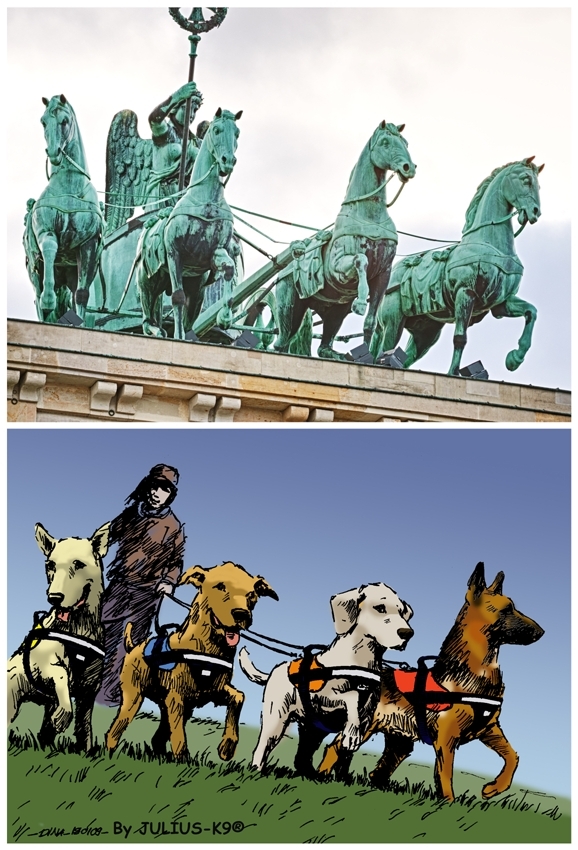
The earliest archaeological find of chest harnesses date back to the Bronze Age. Chest harnesses were traditionally used for horses and draft animals in eastern civilizations, whereas in western cultures full collar harnesses were more popular until more recently. In Berlin, the well-known statues of horses pulling chariots on top of the Brandenburg Gate depict chest harnesses, but this monument was built in the 18th century. In earlier times, German horses would have been more likely to use full collar harnesses. A chest harness fits comfortably on the chest of a horse leaving the whole neck region uncovered and letting the legs to move free.
The chest strap is the most common design of harness in Europe. The “Norweger” and the “K9®” harness have a chest strap which connects the two shoulder joints horizontally at the level of the chest bone. ”IDC®” harnesses also have this feature, but because of their unique design, they merit a separate discussion.
When choosing a dog harness, the anatomy of the dog and the activity to be undertaken should first be considered. You cannot choose a harness specific to a particular breed.
As an example, the chest strap of the IDC® curves downwards in the direction of the sternum. This is not the case with the Norweager and K9® dog harnesses, meaning that the chest strap of these designs can sometimes slide up the neck of the dog, causing choking when the dog is being walked on a leash. For this reason, with short necked dog breeds, a chest lining or chest pad is recommended with a standard chest harness.
The main priority for a chest harness is to protect the blood vessels of the neck and the respiratory system. Various paddings are used on the chest strap to ensure this happens effectively. With the K9® harnesses, for example, the chest strap rests on the sternum and is made from a rigid material which forms a hoop around the chest of the dog. This hoop prevents the shoulder joints from coming into contact with the chest strap when walking or trotting.
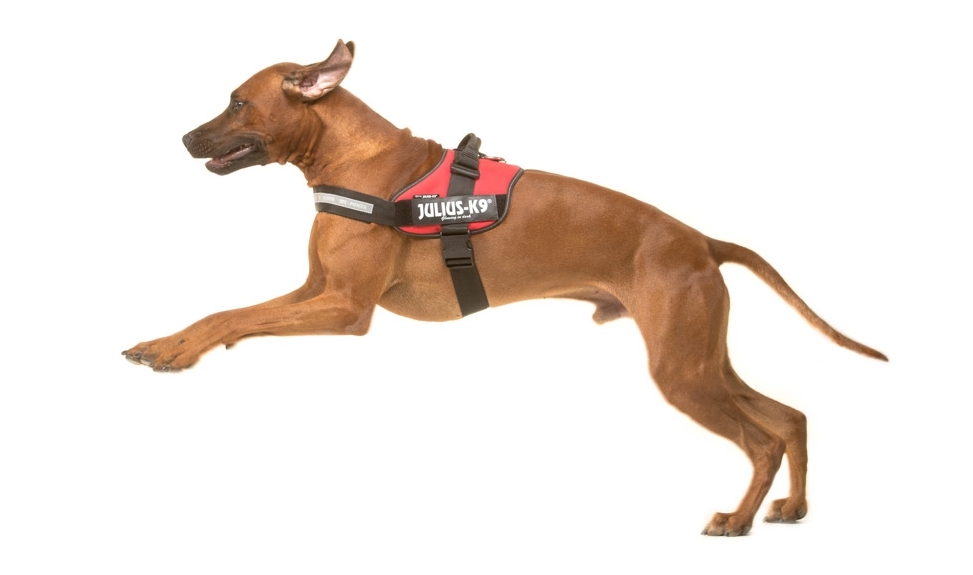
The chest strap easily glides up in the direction of the neck when the dog is jumping or lifting its front legs.
When choosing the correct harness for your dog, you should consult the manufacturer’s size selection and adjustment guide. If you think the chest strap might affect the dog’s movement when leaning forwards, then the IDC® dog harness with a curved chest strap might be a more suitable option. Do not be tempted to get a slightly larger harness for a dog that is still growing as the chest strap may be able to slide down over the dog’s front legs, allowing it to escape.
A chest pad attached to a chest harness provides a useful way of making the harness more secure and harder to escape from. Do not restrict the free movement of the dog’s elbows by adjusting the straps too tightly. It’s safest to refer to the harness instructions for guidelines on fitting these harnesses correctly.
Chest harnesses come with and without a saddle part. The saddle part prevents the carabiner (spring-loaded metal shackle) on the leash from rubbing on the dog’s back while walking.
Advantages of Chest Harnesses
- Easy to put on
- Simple to adjust
- Great freedom of movement
- Available with or without a saddle part
- Julius K9® harnesses include a saddle part which has been manufactured in Europe and has undergone loading tests.
- Positioning of the saddle part can be adjusted by simply using the hook and loop fastener of the chest strap
- Chest pads and Y-straps can be attached to the chest strap when necessary
- Labels can be attached by hook and loop fasteners
Disadvantages of Chest Harnesses
- Without a chest pad, the chest strap can slide up to the neck, putting a heavy burden on the front legs of the dog in weight pulling sports.
- If loosely fitted, the harness can get pulled over the head with the leash.
- Incorrect size selection or adjustment can cause the buckle to rub on the elbow of the dog.
- Options are limited for attachment of a torch.
- Smaller dogs may find the saddle part too rigid.
- Chest harnesses are not suitable for all varieties of dog, so cannot be used for load pulling sports.
IDC® Dog Harnesses: A Combination of Y-harnesses and Chest Harnesses
IDC® dog harnesses are available in two versions – those with a saddle part and those made only of straps. They are the first, and possibly the only, harnesses in the world to base the chest strap line on a mathematical calculation. This trigonometric calculation (2010) allows the chest strap of the harness to fit along the chest of the dog in a similar direction to the expected force when led on a leash, thus avoiding any burden on the neck region.
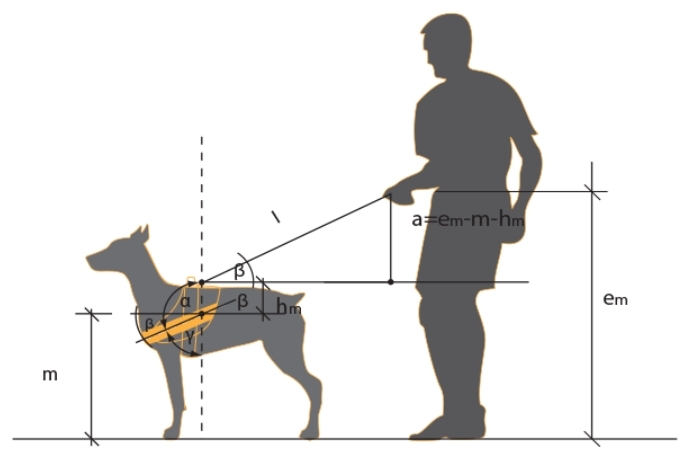
Advantages of IDC® Harnesses
- They are available in two versions: with a saddle part or just with straps.
- The buckle of the belly strap is situated near the back, away from the elbow of the dog, ensuring that it does not interfere with movement, even when adjusted incorrectly.
- The chest strap leaves the neck line completely free.
- As with the Y-harness, the back of the dog’s neck is surrounded by the edging of the saddle part.
- The wide chest strap is a rigid structure, so it rests on the sternum, and as a result it does not move down the legs, therefore it gives maximal freedom of movement.
- Manufactured in Europe, made of components that have been tested and have undergone rigorous inspection.
- Torches and other accessories can be attached to the medium and bigger sizes of harness.
- Labels can be attached to the sides of the harnesses.
Disadvantages of IDC® Harnesses
If the wrong size of harness is used, the chest strap can slide down the front legs.
- The chest pad must be attached separately.
- The smaller sizes (10kg and below) have limited or no options for attaching torches
- The smallest sizes (3.5kg and below) have a more rigid design which can at first seem strange. However tests have shown that this does not affect the dog in any adverse way.
Side View of an IDC Harness
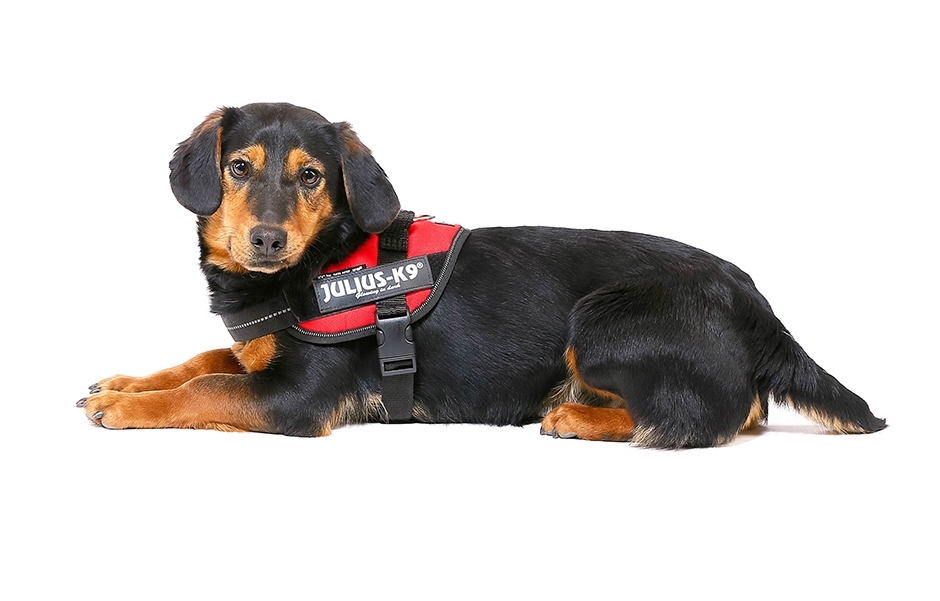
The best position of the chest strap on a puppy
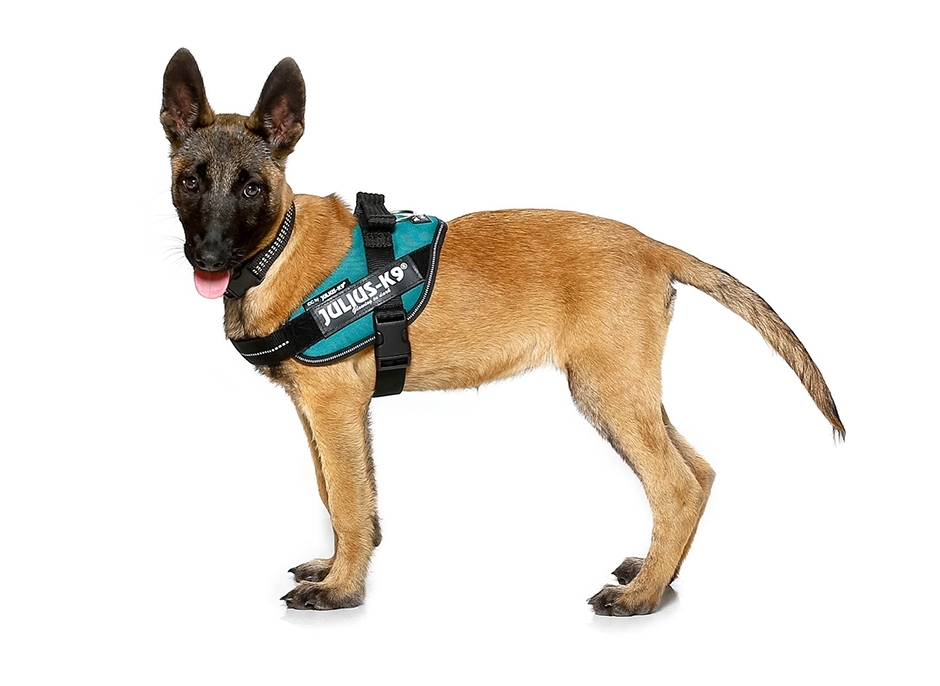
The wide chest strap moves in conjunction with the front legs, and will if necessary slide above the sternum
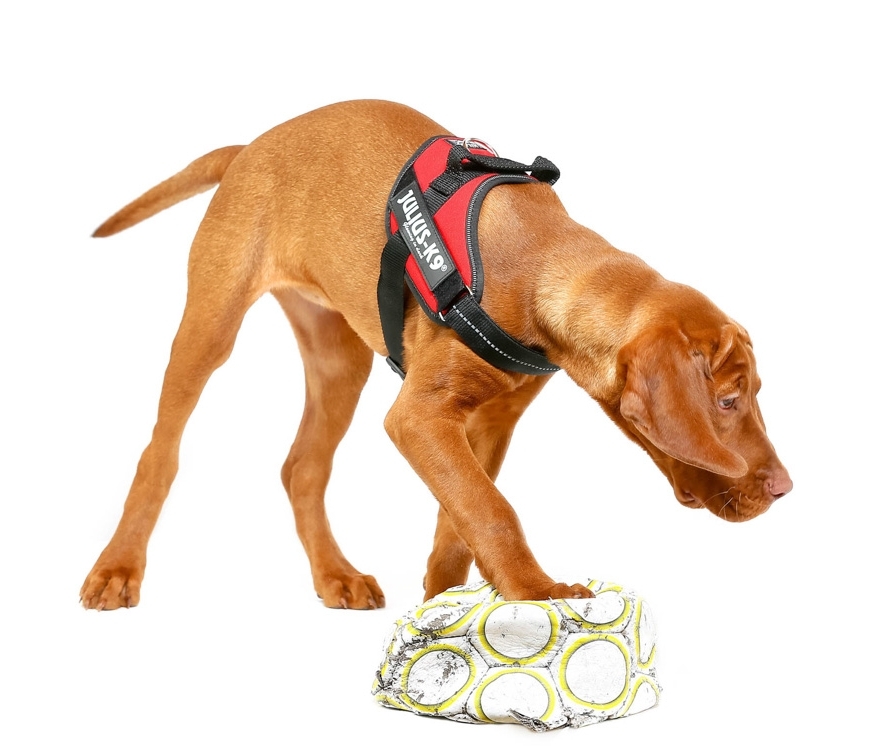
As with the Y-harness, the chest strap sits close to the neckline
Dog harnesses with a saddle part (Y-harnesses and chest harnesses)
All Julius-K9 chest strap designs and sizes are available in versions that can include a saddle part. This attachment rests on the back, partially covering the dog’s sides. Technical equipment such as torches, cameras, bags and labels can be attached to this. This ensures that the equipment does not come into contact with the dog’s body, and therefore does not interfere with the animal’s movement.
With the IDC® harness, the neck line of the saddle part corresponds with the neck straps of the Y-harnesses, assisting with the even distribution of pressure when leading a dog on a leash.
The saddle part comes in a range of colors, including high visibility. It is water repellent on the outside, and made of breathable skin-friendly material (e.g. cotton) on the inside.
Dog shelters prefer to use this type of harness on their dogs, as they find that insecure dogs are more confident when wearing them and being led on a leash.
Check out our products and find the perfect harnesses for your furriend!

